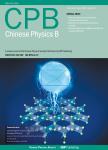The enhancement of light-emitting efficiency using GaN-based multiple quantum well light-emitting diodes with nanopillar arrays
The enhancement of light-emitting efficiency using GaN-based multiple quantum well light-emitting diodes with nanopillar arrays作者机构:Key Laboratory of Advanced Photonic and Electronic Materials School of Electronic Science and Engineering Nanjing University
出 版 物:《Chinese Physics B》 (中国物理B(英文版))
年 卷 期:2013年第22卷第8期
页 面:679-682页
核心收录:
学科分类:08[工学] 0805[工学-材料科学与工程(可授工学、理学学位)] 0803[工学-光学工程] 0704[理学-天文学]
基 金:supported by the Special Funds for Major State Basic Research Project of China(Grant No.2011CB301900) the High Technology Research Program of China(Grant No.2009AA03A198) the National Natural Science Foundation of China(Grant Nos.60990311,60721063,60906025,60936004,60731160628,and 60820106003) the Natural Science Foundation of Jiangsu Province,China(Grant Nos.BK2008019,BK2010385,BK2009255,and BK2010178) the Research Funds from Nanjing University Yangzhou Institute of Opto-electronics,China
主 题:nanopillar arrays InGaN/GaN multiple quantum wells quantum efficiency
摘 要:The quest for higher modulation speed and lower energy consumption has inevitably promoted the rapid development of semiconductor-based solid lighting devices in recent years. GaN-based light-emitting diodes (LEDs) have emerged as promising candidates for achieving high efficiency and high intensity, and have received increasing attention among many researchers in this field. In this paper, we use a self-assembled array-patterned mask to fabricate InGaN/GaN multi- quantum well (MQW) LEDs with the intention of enhancing the light-emitting efficiency. By utilizing inductively coupled plasma etching with a self-assembled Ni cluster as the mask, nanopillar arrays are formed on the surface of the InGaN/GaN MQWs. We then observe the structure of the nanopillars and find that the V-defects on the surface of the conventional structure and the negative effects of threading dislocation are effectively reduced. Simultaneously, we make a comparison of the photoluminescence (PL) spectrum between the conventional structure and the nanopillar arrays, achieved under an experimental set-up with an excitation wavelength of 325 mm. The analysis demonstrates that MQW-LEDs with nanopillar arrays achieve a PL intensity 2.7 times that of conventional LEDs. In response to the PL spectrum, some reasons are proposed for the enhancement in the light-emitting efficiency as follows: 1) the improvement in crystal quality, namely the reduction in V-defects; 2) the roughened surface effect on the expansion of the critical angle and the attenuated total reflection; and 3) the enhancement of the light-extraction efficiency due to forward scattering by surface plasmon polariton modes in Ni particles deposited above the p-type GaN layer at the top of the nanopillars.



